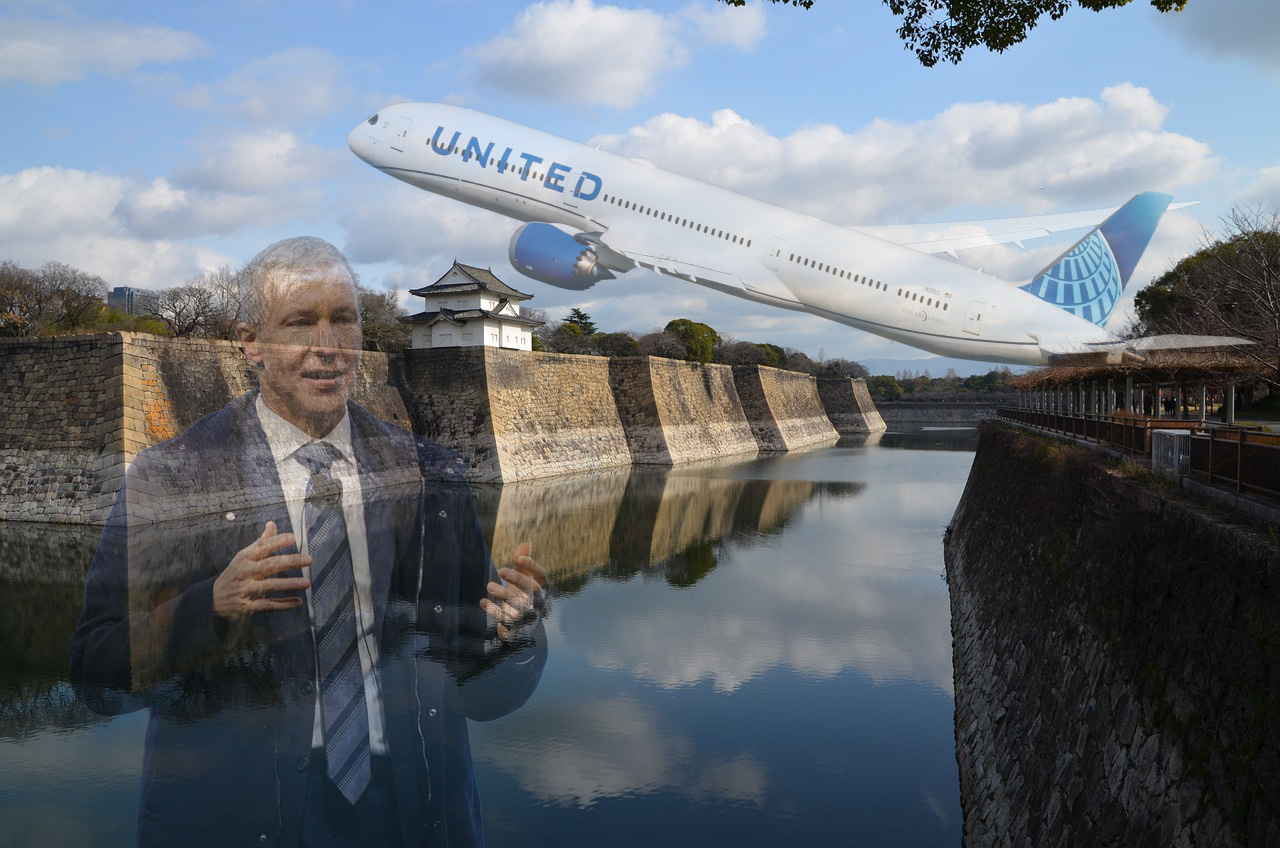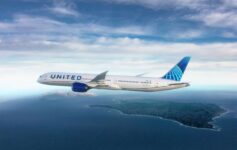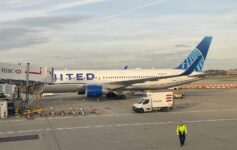
United Airlines CEO Scott Kirby believes United has built a “competitive moat” around its rivals. The imagery of a ring of water around the carrier may not be precise, but Kirby is quite right to point out that structural changes in the airline industry have set United up for success in the years ahead.
United Airlines And Its Competitive Moat
Every quarter, I listen to United’s earnings call and laugh at the language analysts use when questioning United’s C-Suite: words like “color,” “headwind,” and “lumpy.” It’s such investor-class verbiage.
Another term that has come up multiple times in the last year is “competitive moat,” which is essentially a sustainable advantage that a business has over its competitors. That can include unique features of a company’s product or service that make it difficult for competitors to compete.
Kirby loves this phrase and believes that his carrier has, along with Delta Air Lines, built up this moat around its competitors.
Last year, in the 2024 Q1 Earnings call, he elaborated on what he meant:
The industry has structurally changed and United and at least one other have essentially a moat around our business now that never used to be before. The moat, by the way, to be clear, is a moat that is based on having a better proposition for customers. We have a better product, we have a better network, we have a better loyalty program and they choose to fly us. And what makes it unique? Other airlines can have a piece of that, but what makes a couple of airlines unique is we have great products, we have great service, we have a global network, it’s hard to replicate. We can get you to Singapore, two destinations in New Zealand, three in Australia, Cape Town, Marrakesh, Paris and hundreds more.
That was almost a year ago and the point was that United’s varied product offerings, extensive route network, and popular loyalty program made it very difficult to practically replicate.
In a sense, a moat or wall is the wrong term, isn’t it? Yes, United has insulation from its peers, but it’s not the moat itself that provides protection, as it did to castles and villages in centuries past. Instead, the defense is time and money. Manpower too.
Even if the money problem was overcome, there is no rapid route to progress. Let’s say a group of investors got together and wanted to invest in a new carrier. Buying aricraft? Get in line…it’s going to take years (see e.g., Riyadh Air). Delivery delays are adversely impacting the long-term planning of every carrier eying growth. People? Good luck finding the sort of people critical to run an organization on any sort of abbreviated time horizon. Slots? Everything may be possible for a price, but the sort of price investors are willing to stomach considering the historic low margins of the industry.
This week, Kirby returned to the theme of a moat, saying:
Cost convergence…combined with effective revenue diversity at United for the first time ever, and industry-leading product and service causing customers to choose United are just irreversible structural changes that have created a competitive moat for United…[T]here are two additional tailwinds this time around. The international environment…is going to be far stronger for longer because of the structural supply constraints that are going to last at least for the rest of this decade. Wide body supply, both airframes and engines, is even more challenged than narrow bodies.
And second — domestically, the seeds of the 2012 to 2014 era’s demise were being sown at the time with 15% to 20% growth from the ULCC. It’s very hard to see that happening again. Importantly, all of this means that the industry is evolving into an equilibrium where each airline driven by economic necessity will be primarily focused on flying where they have a competitive advantage.
In short, Kirby believes the delay in delivering aircraft makes it impossible for others to catch up to United. He also thinks that investors have wised up and are not going to pour money into ultra-low-cost carriers when the business model fundamentally does not work due to high fixed costs (we’ll explore this issue a bit more tomorrow).
I would never use the word “irreversible” and I also think that most folks, investors included (and perhaps investors especially) have short-term memories. Therefore, I expect that even if some budget carriers we know today do not survive, new ones will rise from the ashes. Kirby is right to point out the structural difficulties in running a budget carrier in the USA, but those do not strike me as irreversible.
CONCLUSION
Moats provide defense against others, but they are not impenetrable. Kirby is quite right that United has built up a competitive moat around it and that will buoy it for years to come, absent a sharp economic downturn, war, or another pandemic. But to borrow another metaphor, Kirby would be wise not to forget that the bridge must be lowered to attract people into the castle…if folks don’t want to fly United or spend on a United co-branded credit card, the moat will become moot. It’s time to build more bridges before rejoicing over moats.




‘Great products’ is relative and debatable, but my couple of experiences with UA weren’t really characterised by great service.
But what’s the point in saying ‘we can get you to Paris and Australia’ as if there didn’t exist dozens of other airlines flying there? I could’ve seen the value in saying something like ‘we’re a truly global carrier and will happily sell you a seamless connection from Dhaka to Mozambique’- but he doesn’t work for Turkish Airlines!
Kirby comes across as insufferably shallow to me. He’s basically saying ‘we’re better than American Airlines’. Well done!
@PM … Yes , “insufferably shallow” is correct .
He’s basically saying ‘we’re better than American Airlines’. Well done!
LOL. So true. But, even then, that’s hardly noteworthy as AA sets a ridiculously low bar.
Yes, @pm, @alert and @dcawabn… agree with all of you. “Insufferably shallow” best describes Kirby,
Not sure why he thinks United has a moat, whats stopping Delta or American from flying from Christchurch and Marrakesh? The real moat is how United has uncompetitive fortress hubs where it owns gates and restricts the use of those to competitors (SFO, IAH, EWR, IAD) in particular
Bingo.
IAD’s other concourse feels empty half the time. Hardly uncompetitive.
Disappointed that Kirby didn’t build a real moat
Describe Kirby in two words: INSUFFERABLE and ARROGANT
There was another one who built a ‘moat’ around American Airlines. It was so great that AA would never be non-profitable again…
To my understanding an economic moat is a concept popularized by Warren Buffet. In the way that this concept is spoken of by Buffett, it seems fair to me to suggest that United has a moat. I’d argue that the strength or durability of this moat isn’t optimal, but probably is better than some others in the industry.
From my perspective, October 2023 was the end of my allegiance to (originally Continental and then) United. I couldn’t be happier. What have I missed? Not much really– the United Club at Heathrow. I wish I still had that. United does still offer a great selection of flights to/from Hawaii from my home base, which I can still buy of course, but would prefer to get on points… Otherwise…. maybe the Polaris lounge at Newark, I mean I like that lounge, but on the other hand, it means I’m at Newark, so that’s kind of a wash
I think the one thing that UA got right, and which both DL and AA got very wrong, was how they handled aircraft retirement during the pandemic. Both DL and AA retired wide swathes of their widebody fleet, leaving them ill-equipped to handle the sudden rebound in travel, particularly international travel. UA retired none of the aircraft they used for international travel; the only aircraft they did retire was their pmUA 752s which were used exclusively on SFO/LAX-EWR. This decision has maybe crimped their ability to service some secondary TATL destinations because they need to devote the pmCO 752s to SFO/LAX-EWR more exclusively, especially during the summer, but it is nowhere near the self-own that their main competitors dealt themselves by retiring a material number of widebodies – whereas UA literally retired zero of theirs.
For all the hate Kirby gets, that was an incredibly smart, strategic, and longer-term view to take than how airlines usually tend to behave, and I will give him kudos for that.
Lmao what a stretch for the title
Kirby is right about the route structure being the best among domestic airlines. The rest – meh. @dan is right and American has done a stunningly superb job of hiring idiots to run the airline ever since the merger with USair. Had AA been run by competent leaders instead of inept managers then American would be vying with Delta. Delta is so tough because of their fortress hubs, a problem that needs to be addressed but at best it’s four years away until the government will challenge the increasingly uncompetitive status quo..
Arrogance and pettiness will bring down United. Kirby keeps comparing United to Delta, that’s a sign of insecurity, and the constant shade on AA is just pettiness. If United is truly the best airline in the world, then there’s simply no peer to compare itself to.
The only most Kirby is building is a most around Mar-A-Lago, and it’s intention is to keep out Robbie, Eddie, and what’s left of his principles.
Moat*,
I remember when the one company NOBODY could compete with in the IT industry had three letters:
IBM
(And no, that doesn’t mean I Bowel Movement).
They had sales dominance that didn’t decline until the early 2000’s. There was even a joke that went: “Nobody ever got fired for buying IBM”.
Microsoft would eventually dominate and then later, Apple as the Microsoft phone bombed. Apple had been down for the count several times but came back. I’m thinking of dropping the Apple OSX platform in that it’s just not well supported, quite frankly.
Anyways, never say never. But yet, United has market momentum at this point. Delta doesn’t offer much to me for the flights I want to take and American has a lousy FF program for us. I’m wondering if the Jetblue/Spirit merger might have helped to shake up the industry a bit.
Always have a good laugh when terms such as “Moat” come up at cyclical peaks to describe companies that have rarely if ever been good investments. They classically have just finished doling out huge pay raises that can’t be continued in a downturn. The third bailout since the dot com and pandemic ones will soon be requested and not available.
I actually believe that moat is the correct phrase, however extending that analogy, I also believe that United’s continued devaluation of miles combined with the recent changes to the earning status, have laid a bridge over their moat. I hear plenty of conversations with high status members in lounges and on flights about whether the programs they offer are worth it. A competitive advantage only stays that way of you nurture it, once you take it for granted it’s only a matter of time before you are on the other side of that moat…
I would prefer to fly United but haven’t in at least 10 years for 1 simple reason: they charge for carry on bags. I usually fly AA for this reason, and they are usually cheaper out of ORD. That being said, I realize I’m not the type of flyer that United wants, or cares about. Although I also fly internationally at least twice a year, so maybe United should care.